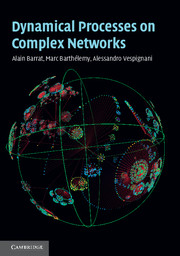Book contents
- Frontmatter
- Contents
- Preface
- Acknowledgements
- List of abbreviations
- 1 Preliminaries: networks and graphs
- 2 Networks and complexity
- 3 Network models
- 4 Introduction to dynamical processes: theory and simulation
- 5 Phase transitions on complex networks
- 6 Resilience and robustness of networks
- 7 Synchronization phenomena in networks
- 8 Walking and searching on networks
- 9 Epidemic spreading in population networks
- 10 Social networks and collective behavior
- 11 Traffic on complex networks
- 12 Networks in biology: from the cell to ecosystems
- 13 Postface: critically examining complex networks science
- Appendix 1 Random graphs
- Appendix 2 Generating functions formalism
- Appendix 3 Percolation in directed networks
- Appendix 4 Laplacian matrix of a graph
- Appendix 5 Return probability and spectral density
- References
- Index
Appendix 3 - Percolation in directed networks
Published online by Cambridge University Press: 05 September 2012
- Frontmatter
- Contents
- Preface
- Acknowledgements
- List of abbreviations
- 1 Preliminaries: networks and graphs
- 2 Networks and complexity
- 3 Network models
- 4 Introduction to dynamical processes: theory and simulation
- 5 Phase transitions on complex networks
- 6 Resilience and robustness of networks
- 7 Synchronization phenomena in networks
- 8 Walking and searching on networks
- 9 Epidemic spreading in population networks
- 10 Social networks and collective behavior
- 11 Traffic on complex networks
- 12 Networks in biology: from the cell to ecosystems
- 13 Postface: critically examining complex networks science
- Appendix 1 Random graphs
- Appendix 2 Generating functions formalism
- Appendix 3 Percolation in directed networks
- Appendix 4 Laplacian matrix of a graph
- Appendix 5 Return probability and spectral density
- References
- Index
Summary
In Chapter 6, the case of percolation and resilience of undirected graphs has been considered. Various authors have tackled the problem of its generalization to directed networks (Newman et al., 2001; Schwartz et al., 2002; Dorogovtsev et al., 2001a; Boguñá and Serrano 2005).
As seen in Chapter 1, directed networks are topologically richer and more complex than their undirected counterparts. The links attached to a node can be either incoming or outgoing. The number of in-links is the in-degree kin, and the number of out-links is the out-degree kout. Since some pairs of nodes can be linked by two directed links pointing in the opposite directions, it is also possible to distinguish between strictly incoming, strictly outgoing or bidirectional links, the total degree being the sum of their respective numbers ki, ko, kb, with kin = ki + kb and kout = ko + kb. The degree distribution is thus the joint distribution of these degrees. Most often, strictly directed networks are considered, with no bidirectional links: kb = 0. Note that by a simple conservation rule, the averages of ki and ko are then equal: 〈ki〉 = 〈ko〉. Each (weakly) connected component (WCC) of a directed graph has also an internal structure as described in Chapter 1, and is composed of a strongly connected component (SCC), an in and an out components, tendrils and tubes.
- Type
- Chapter
- Information
- Dynamical Processes on Complex Networks , pp. 306 - 309Publisher: Cambridge University PressPrint publication year: 2008



